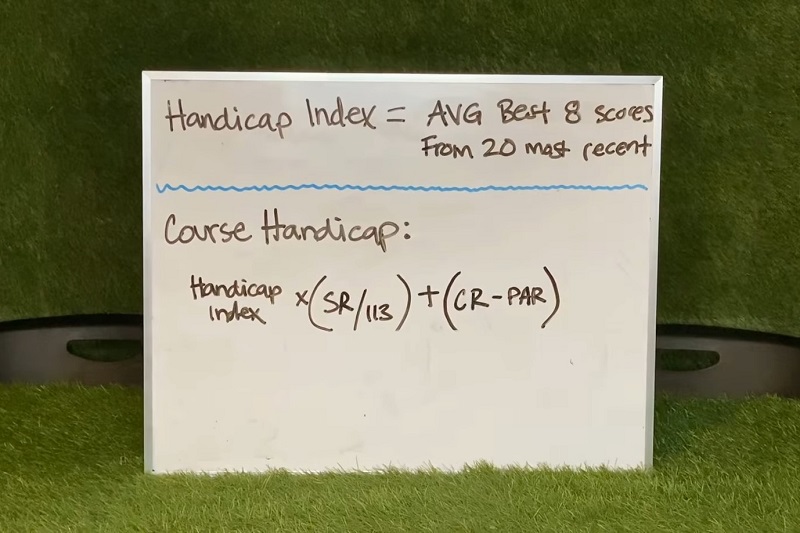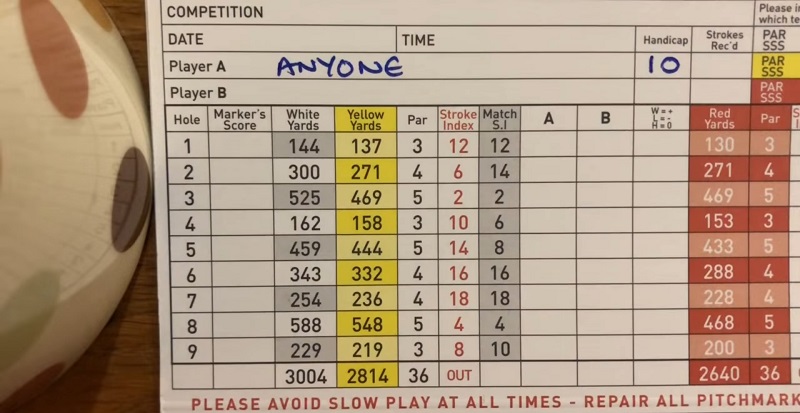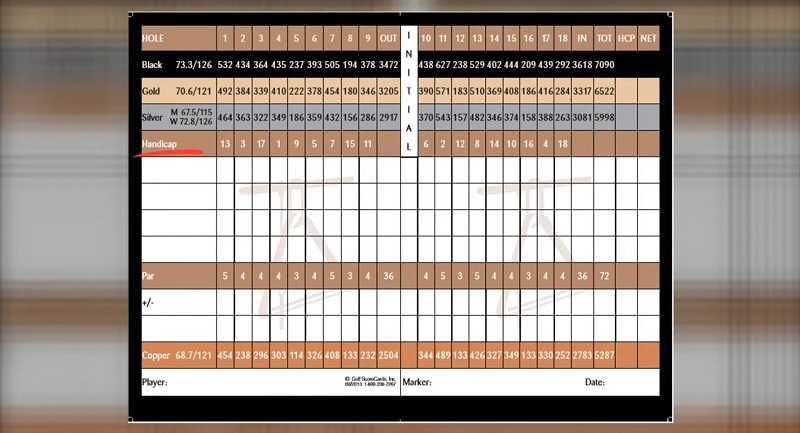Golf handicaps are a great way to measure your golf game, no matter what your level of skill. They help you track individual improvement, provide helpful insights on how to raise the bar and create an even playing field among different golfers. This article will explain what exactly a golf handicap is and go through how to calculate it.
What are Golf Handicaps?
A golf handicap is a numerical measure of a golfer’s potential ability. It is used to level the playing field for players of different skill levels, allowing them to compete against each other on an even footing. The lower the handicap, the better the player is considered to be. Handicaps are calculated using a variety of factors, including recent scores and course difficulty ratings. They are regularly updated as players participate in tournaments or other events where their performance can be measured. Understanding how golf handicaps work can help you improve your game and become more competitive on the course.
Handicaps are expressed as a number between 0 and 36 for men and 0-24 for women— the higher the number, the less skilled a golfer is considered to be. The handicap number is the total strokes a player is expected to take over an 18-hole course, compared with a scratch golfer — someone who shoots par for every hole. For example, if your handicap is 12, you are expected to score 12 strokes more than par on an average round of golf.
A handicap can help players identify their strengths and weaknesses, allowing them to focus on specific aspects of their game. It also makes it easier for players to join groups or tournaments that are appropriate for their skill level. Finally, having an up-to-date handicap is a requirement if you wish to track your progress over time.
Although golf handicaps can be calculated manually, many courses and clubs now use automated systems to keep track of a player’s handicap index. These systems provide instant and accurate updates that are based on the most recent rounds played by each golfer. Knowing your course handicap or index can help you gain an edge over your opponents, allowing you to make better decisions and play smarter golf.
History of Golf Handicaps

Golfers have been using handicaps to level the playing field for centuries. The earliest known record of golf handicapping comes from a diary kept by Thomas Kincaid in the late 17th century. Back then, golfers negotiated the number of strokes to be given and the holes on which they would take effect before the start of play.
As the sport grew, so did the need for a more standardized and fair system. In the late 19th century, England and Scotland adopted a method that compared a golfer’s best three scores with par. Meanwhile, in the United States, the USGA introduced the first national handicap system in 1911. By 2020, a new World Handicap System was introduced to create more consistency and portability across different countries’ handicapping systems.
What is The World Handicap System?
The World Handicap System (WHS) was created by The R&A and the USGA to unify the many different handicapping systems used worldwide, which make it difficult to compete fairly, launched in 2020. The WHS combines features from six major handicap systems and is based on the USGA Course and Slope Rating system.
For players with current handicaps, their records from the old systems will be used to produce WHS handicaps, and most players will see little difference. To establish a new WHS handicap, golfers must submit several scores, with a recommended minimum of 54 holes.
Unlike some other systems, both competitive and recreational rounds can be submitted, and adjustments are made based on the average of the best 8 differentials with an “anchor” to prevent rapid increases. The WHS also has a hole limit of “net double bogey” for handicapping purposes to prevent a few bad holes from having a disproportionate effect.
Six Major Handicap Systems before the World Handicap System: USGA Handicap System, EGA Handicap System, Argentinian Handicap System, South African Handicap System, Golf Australia Handicap System, and CONGU Unified Handicap System.
How are Golf Handicaps Calculated?

If you’re a golf enthusiast, you might want to know how to calculate your golf handicap. Your handicap is a numerical representation of your skill level in golf. The lower your handicap, the better you are at the game. Here’s a brief explanation of how the World Handicap System (WHS) calculates your handicap index:
Determine Your Handicap Index
The Handicap Index is calculated using the best 8 out of your last 20 scores, with adjustments made for the difficulty of the course and the tees played. The formula to calculate the Handicap Index is as follows:
Handicap Index = (Adjusted Gross Score – Course Rating) x 113 / Slope Rating
- Adjusted Gross Score: This is your gross score adjusted for any Net Double Bogey or maximum hole score limits. Net Double Bogey is the maximum score on a hole that can be recorded for handicap purposes, and it is equal to par plus 2 strokes plus any handicap strokes you receive on that hole.
- Course Rating: This is the expected score for a scratch golfer playing the course.
- Slope Rating: This is a measure of the relative difficulty of a course for bogey golfers, relative to a scratch golfer.
Calculate Your Course Handicap
Your Course Handicap is the number of strokes that you will receive or give back on a specific course. It is calculated based on the difficulty of the course, as determined by its Course Rating and Slope Rating. The formula to calculate your Course Handicap is as follows:
Course Handicap = Handicap Index x (Slope Rating / 113) + (Course Rating – Par)
- Par: This is the expected score for a scratch golfer playing the course.
Adjust Your Course Handicap For the Specific Set of Tees You Will be Playing From
The WHS provides a Course Handicap table that takes into account the Course Rating, Slope Rating, and the specific tees you will be playing from to determine your Course Handicap. You can use the table or an online calculator to adjust your Course Handicap.
Apply Playing Conditions Calculation (PCC)
In addition to the Course Handicap, the WHS also applies a Playing Conditions Calculation (PCC) to adjust handicaps for abnormal playing conditions, such as weather or course setup. The PCC can adjust all handicaps at a specific course, and the adjustment is made after scores have been submitted.
To summarize, the steps to calculate handicaps for golfers using the World Handicap System are as follows:
- Determine your Handicap Index using the formula: Handicap Index = (Adjusted Gross Score – Course Rating) x 113 / Slope Rating
- Calculate your Course Handicap using the formula: Course Handicap = Handicap Index x (Slope Rating / 113) + (Course Rating – Par)
- Adjust your Course Handicap for the specific set of tees you will be playing from using the Course Handicap table or an online calculator.
- Apply the Playing Conditions Calculation (PCC) to adjust handicaps for abnormal playing conditions.
Note: The formulas provided in this guide are for informational purposes only. It is recommended to seek guidance from a golf professional or your national golf association to ensure proper calculation of your handicap.
What are “Soft” and “Hard” Caps?
To prevent a handicap index from rising too quickly, the WHS has implemented “soft” and “hard” caps. These caps are based on the lowest index during the previous 365 days. The soft cap reduces increases above 3.0 to 50%, and the hard cap limits increase to 5.0.
Flexibility in the World Handicap System (WHS)
Many elements of the WHS have the flexibility that allows local authorities to determine their settings. For example, 9-hole scores may be scaled up rather than combined, and certain variables may be omitted from the course handicap calculation. Additionally, the rounded course handicap may be used in the playing handicap calculation.
What is a Good Golf Handicap?

A good golf handicap is relative to a player’s skill level, experience, and the level of competition they are playing in. In general, the lower the handicap, the better the player.
In the United States, the average handicap for men is around 16, while the average for women is around 28. However, this does not mean that a handicap above these averages is not considered good.
Here are some general guidelines for what could be considered a good handicap:
- Beginner golfers typically have handicaps of 30 or higher.
- Intermediate golfers usually have handicaps in the range of 10-20.
- Advanced golfers often have handicaps below 10.
However, it is important to note that these are just general guidelines and not definitive. A player’s handicap is influenced by many factors such as age, physical ability, practice time, natural talent, and competition level.
Ultimately, the goal for any golfer is to improve their game and lower their handicap over time.
What Does Handicap Mean to Golfers?
A handicap is a valuable tool for golfers that allows them to compete on an equal footing with players of different skill levels. It is used to assign scores to each player to level the playing field and make the game more enjoyable for everyone involved. A handicap measures a golfer’s potential, accounting for their average score over several rounds. This number can then be used to compare the relative abilities of different players, regardless of their individual strengths and weaknesses.
For example, if a golfer with a handicap of 10 were to play against someone with a handicap of 20, the lower-handicapped player would get a 10-stroke advantage on certain holes. This allows them to compete on an even playing field and gives both players a chance to win rather than giving the advantage to the more experienced player.
Handicaps can be used by golfers of all levels, from beginners to experienced professionals. They allow players of different abilities to compete against one another in matches or tournaments and make the sport more enjoyable and inclusive. Additionally, they make it easier for golfers to track their progress as they become better players. By regularly adjusting their handicaps, golfers can see how much they have improved and set goals to reach higher levels of competition.
In short, handicaps are an invaluable asset to any golfer that hopes to improve their game and compete with players of all levels. They provide a level playing field that allows everyone to enjoy the game without feeling like they are at a disadvantage. With handicaps, golfers can track their progress, set realistic goals, and gain the confidence they need to take their game to the next level.
How to Improve Your Handicaps?
One of the most rewarding aspects of golf is improving your handicap. To improve your golf game, there are several techniques you can use.
First, play as often as possible and focus on your practice. Take the time to review and analyze each shot to identify your weaknesses and areas for improvement. Consider the best club for each shot and practice hitting them to perfection.
Focusing on your physical fitness, especially your core and flexibility, is also important. Working out regularly will increase your strength and endurance to play with more power, accuracy and consistency.
It would help if you also focused on your mental game by learning to stay in the present moment and remain calm and focused during each shot. Visualizing successful shots can help you stay positive even when you make mistakes.
Finally, work on your course management and shot selection skills by studying courses before you play, knowing your distances with different clubs and picking the right club for each shot. This will give you an overall strategy on how to approach each hole.
Final Thoughts
While we have learned a lot about what golf handicaps are, how to calculate them and the meaning of golf handicaps, there is still much to understand when it comes to mastering the game of golf. With each additional round and result, you can build your confidence in understanding your own handicap and how to better compete with other players at the same skill level.
With the correct tools and information, any golfer can track their progress over time as they gain skills and knowledge on the links course. Ultimately a clearer picture of performance will be revealed so that every golfer can reach their personal best when playing a round of enjoyable, competitive golf.
FAQs
What Does It Mean To Have A 20 Handicap In Golf?
Having a 20 handicap in golf suggests that a player is moderately skilled. It indicates they typically score about 20 strokes above the course’s par. A higher handicap generally implies less experience and skill in the game.
If I Score 90 In Golf, What Is My Handicap?
If you’re consistently scoring 90, your handicap would generally be around 18, assuming the course is a par 72. This is only a rough estimate, as precise calculation involves more factors.
What Does A +3 Handicap Mean In Golf?
A +3 handicap in golf signifies an exceptionally skilled player, typically professional or near-professional level. Such a player, on average, is expected to finish 3 strokes under par on a course. Essentially, a positive handicap means the player is likely to score below par consistently.
Is There A Highest Possible Handicap In Golf?
According to the USGA, the maximum handicap is 54.0 for all players. These limits are set by the World Handicap System.
What Is A Category 1 Golfer In Golf Terms?
A Category 1 golfer in golf terms refers to a player with a handicap of 5 or less. These golfers are highly skilled, typically able to consistently shoot scores around or just above par on most courses. It’s the lowest category in the handicap system, denoting advanced performance.
What Golf Handicap Is Needed To Become A PGA Pro?
To become a PGA pro, a player must consistently score a handicap of 4 or better. This is a strict requirement as it signifies the ability to compete at professional-level tournaments.
References: https://en.wikipedia.org/wiki/Handicap_(golf)


